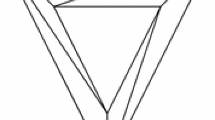Abstract
In this paper a triangulation is introduced for homotopy methods to compute fixed points on the unit simplex or inR n. This triangulation allows for factors of incrementation of more than two. The factor may be of any size and even different at each level. Also the starting point on a new level may be any gridpoint of the last found completely labelled subsimplex on the last level. So, the decision which new factor of incrementation and which starting point is used, can be made on the ground of previous approximations. Doing so, the convergence rate can be accelerated without using restart methods.
Similar content being viewed by others
References
B.C. Eaves, “Homotopies for computation of fixed points”,Mathematical Programming 3 (1972) 1–22.
B.C. Eaves and R. Saigal, “Homotopies for computation of fixed points on unbounded regions”,Mathematical Programming 3 (1972) 225–237.
H.W. Kuhn, “Some combinatiorial lemmas in topology”,IBM Journal of Research and Development 4 (1960) 518–524.
H.W. Kuhn and J.G. MacKinnon, “Sandwich method for finding fixed points”,Journal of Optimization Theory and Applications 17 (1975) 189–204.
G. van der Laan and A.J.J. Talman, “A restart algorithm for computing fixed points without an extra dimension”,Mathematical Programming 17 (1979) 74–84.
G. van der Laan and A.J.J. Talman, “A restart algorithm without an artificial level for computing fixed points on unbounded regions” in: H.O. Peitgen and H.O. Walther, eds.,Functional differential equations and approximation of fixed points, Lecture Notes in Mathematics 730 (Springer, Berlin, 1979) pp. 247–256.
G. van der Laan and A.J.J. Talman, “An improvement of fixed point algorithms by using a good triangulation,”Mathematical Programming 18 (1980) 274–285.
G. van der Laan and A.J.J. Talman, “A class of simplicial subdivisions for restart fixed point algorithms without an extra dimension”,Mathematical Programming, to appear.
G. van der Laan and A.J.J. Talman, “Convergence and properties of recent variable dimension algorithms”, in: W. Forster, ed.,Numerical solution of highly nonlinear problems (North-Holland, Amsterdam, 1980) pp. 3–36.
O.H. Merrill, “Applications and extensions of an algorithm that computes fixed points of certain upper semi-continuous point to set mappings”, Ph.D. Thesis, University of Michigan (Ann Arbor, MI, 1972).
P.M. Reiser, “A modified integer labelling for complementarity algorithms”, Institute of Operations Research, University of Zürich, (Zürich, Switzerland, 1978).
R. Saigal, “On the convergence of algorithms for solving equations that are based on methods of complementary pivoting”,Mathematics of Operations Research 2 (1977) 108–124.
R. Saigal and M.J. Todd, “Efficient acceleration techniques for fixed point algorithms”,SIAM Journal of Numerical Analysis 15 (1978) 997–1007.
M.J. Todd,The computation of fixed points and applications (Springer, Berlin, 1976).
M.J. Todd, “Fixed point algorithms that allow restarting without an extra dimension”, Technical Report No. 379, Cornell University (Ithaca, NY, 1978).
Author information
Authors and Affiliations
Rights and permissions
About this article
Cite this article
van der Laan, G., Talman, A.J.J. A new subdivision for computing fixed points with a homotopy algorithm. Mathematical Programming 19, 78–91 (1980). https://doi.org/10.1007/BF01581629
Received:
Revised:
Issue Date:
DOI: https://doi.org/10.1007/BF01581629




